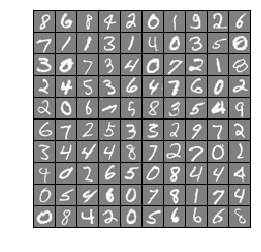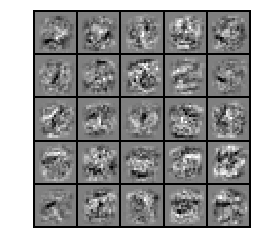Exercise 4 Neural Network Learning
=========== Part 1: Loading and Visualizing Data =============
## Setup the parameters you will use for this exercise
input_layer_size = 400 # 20x20 Input Images of Digits
hidden_layer_size = 25 # 25 hidden units
num_labels = 10 # 10 labels, from 1 to 10
# (note that we have mapped "0" to label 10)
# Load Training Data
print('Loading and Visualizing Data ...')
from ex4 import *
from scipy import io as sio
data = sio.loadmat('ex4data1.mat')
X = data['X']
y = data['y'].reshape(-1)
m = X.shape[0]
print(y[:10])
# Randomly select 100 data points to display
sel = np.random.permutation(m)
sel = sel[:100]
%matplotlib inline
_ = displayData(X[sel, :])
Loading and Visualizing Data ...
[10 10 10 10 10 10 10 10 10 10]

================ Part 2: Loading Parameters ================
print('Loading Saved Neural Network Parameters ...')
# Load the weights into variables Theta1 and Theta2
data = sio.loadmat('ex4weights.mat')
Theta1 = data['Theta1']
Theta2 = data['Theta2']
print(Theta1.shape, Theta2.shape)
# Unroll parameters
nn_params = np.concatenate([Theta1.reshape(-1), Theta2.reshape(-1)])
print(nn_params.shape)
Loading Saved Neural Network Parameters ...
(25, 401) (10, 26)
(10285,)
============= Part 3: Compute Cost (Feedforward) =============
代价函数
print('Feedforward Using Neural Network ...')
# Weight regularization parameter (we set this to 0 here).
lambda_ = 0
J, _ = nnCostFunction(nn_params, input_layer_size, hidden_layer_size, num_labels, X, y, lambda_)
print(f'Cost at parameters (loaded from ex4weights): {J:f} \n(this value should be about 0.287629)')
Feedforward Using Neural Network ...
Cost at parameters (loaded from ex4weights): 0.287629
(this value should be about 0.287629)
============== Part 4: Implement Regularization ==============
print('Checking Cost Function (w/ Regularization) ... ')
# Weight regularization parameter (we set this to 1 here).
lambda_ = 1
J, _ = nnCostFunction(nn_params, input_layer_size, hidden_layer_size, num_labels, X, y, lambda_)
print(f'Cost at parameters (loaded from ex4weights): {J:f} \n(this value should be about 0.383770)')
Checking Cost Function (w/ Regularization) ...
Cost at parameters (loaded from ex4weights): 0.383770
(this value should be about 0.383770)
================ Part 5: Sigmoid Gradient ================
print('Evaluating sigmoid gradient...')
g = sigmoidGradient(np.array([-1, -0.5, 0, 0.5, 1]))
print('Sigmoid gradient evaluated at [-1 -0.5 0 0.5 1]: ')
print(f'{g}')
Evaluating sigmoid gradient...
Sigmoid gradient evaluated at [-1 -0.5 0 0.5 1]:
[0.196612 0.235004 0.25 0.235004 0.196612]
================ Part 6: Initializing Pameters ================
print('Initializing Neural Network Parameters ...')
initial_Theta1 = randInitializeWeights(input_layer_size, hidden_layer_size)
initial_Theta2 = randInitializeWeights(hidden_layer_size, num_labels)
# Unroll parameters
initial_nn_params = np.concatenate([initial_Theta1.reshape(-1), initial_Theta2.reshape(-1)])
print(initial_nn_params[:5])
Initializing Neural Network Parameters ...
[ 0.066709 0.088432 0.010104 -0.059409 -0.01829 ]
============= Part 7: Implement Backpropagation =============
梯度计算
print('Checking Backpropagation... ')
# Check gradients by running checkNNGradients
checkNNGradients()
Checking Backpropagation...
[[ 1.231622e-02 1.231622e-02]
[ 1.738282e-04 1.738282e-04]
[ 2.614551e-04 2.614551e-04]
[ 1.087014e-04 1.087015e-04]
[ 3.924714e-03 3.924714e-03]
[ 1.901013e-04 1.901013e-04]
[ 2.222723e-04 2.222723e-04]
[ 5.008725e-05 5.008725e-05]
[-8.084594e-03 -8.084594e-03]
[ 3.131706e-05 3.131706e-05]
[-2.178403e-05 -2.178403e-05]
[-5.485698e-05 -5.485699e-05]
[-1.266691e-02 -1.266691e-02]
[-1.561302e-04 -1.561302e-04]
[-2.455062e-04 -2.455062e-04]
[-1.091649e-04 -1.091649e-04]
[-5.593425e-03 -5.593425e-03]
[-2.000366e-04 -2.000366e-04]
[-2.436302e-04 -2.436302e-04]
[-6.323137e-05 -6.323137e-05]
[ 3.093477e-01 3.093477e-01]
[ 1.610671e-01 1.610671e-01]
[ 1.470365e-01 1.470365e-01]
[ 1.582686e-01 1.582686e-01]
[ 1.576167e-01 1.576167e-01]
[ 1.472364e-01 1.472364e-01]
[ 1.081330e-01 1.081330e-01]
[ 5.616337e-02 5.616337e-02]
[ 5.195105e-02 5.195105e-02]
[ 5.473534e-02 5.473534e-02]
[ 5.530828e-02 5.530828e-02]
[ 5.177526e-02 5.177526e-02]
[ 1.062704e-01 1.062704e-01]
[ 5.576110e-02 5.576110e-02]
[ 5.055681e-02 5.055681e-02]
[ 5.388051e-02 5.388051e-02]
[ 5.474072e-02 5.474072e-02]
[ 5.029295e-02 5.029295e-02]]
The above two columns you get should be very similar.
(Left-Your Numerical Gradient, Right-Analytical Gradient)
If your backpropagation implementation is correct, then
the relative difference will be small (less than 1e-9).
Relative Difference: 2.09633e-11
============== Part 8: Implement Regularization ==============
print('Checking Backpropagation (w/ Regularization) ... ')
# Check gradients by running checkNNGradients
lambda_ = 3
checkNNGradients(lambda_)
# Also output the costFunction debugging values
debug_J, _ = nnCostFunction(nn_params, input_layer_size, hidden_layer_size, num_labels, X, y, lambda_)
print(f'\nCost at (fixed) debugging parameters (w/ lambda = {lambda_:f}): {debug_J:f} '
'\n(for lambda = 3, this value should be about 0.576051)')
Checking Backpropagation (w/ Regularization) ...
[[ 0.012316 0.012316]
[ 0.054732 0.054732]
[ 0.008729 0.008729]
[-0.045299 -0.045299]
[ 0.003925 0.003925]
[-0.016575 -0.016575]
[ 0.039641 0.039641]
[ 0.059412 0.059412]
[-0.008085 -0.008085]
[-0.03261 -0.03261 ]
[-0.060021 -0.060021]
[-0.032249 -0.032249]
[-0.012667 -0.012667]
[ 0.05928 0.05928 ]
[ 0.038772 0.038772]
[-0.017383 -0.017383]
[-0.005593 -0.005593]
[-0.045259 -0.045259]
[ 0.008749 0.008749]
[ 0.054713 0.054713]
[ 0.309348 0.309348]
[ 0.215625 0.215625]
[ 0.155504 0.155504]
[ 0.11286 0.11286 ]
[ 0.100081 0.100081]
[ 0.130471 0.130471]
[ 0.108133 0.108133]
[ 0.115525 0.115525]
[ 0.076678 0.076678]
[ 0.022094 0.022094]
[-0.004691 -0.004691]
[ 0.019581 0.019581]
[ 0.10627 0.10627 ]
[ 0.115198 0.115198]
[ 0.089574 0.089574]
[ 0.036606 0.036606]
[-0.002943 -0.002943]
[ 0.005234 0.005234]]
The above two columns you get should be very similar.
(Left-Your Numerical Gradient, Right-Analytical Gradient)
If your backpropagation implementation is correct, then
the relative difference will be small (less than 1e-9).
Relative Difference: 1.95725e-11
Cost at (fixed) debugging parameters (w/ lambda = 3.000000): 0.576051
(for lambda = 3, this value should be about 0.576051)
=================== Part 8: Training NN ===================
print('Training Neural Network... ')
# After you have completed the assignment, change the MaxIter to a larger
# value to see how more training helps.
options = {'maxiter': 400}
# You should also try different values of lambda
lambda_ = 1;
# Create "short hand" for the cost function to be minimized
fun = lambda nn_params: nnCostFunction(nn_params, input_layer_size, hidden_layer_size, num_labels, X, y, lambda_)[0]
jac = lambda nn_params: nnCostFunction(nn_params, input_layer_size, hidden_layer_size, num_labels, X, y, lambda_)[1]
# Now, costFunction is a function that takes in only one argument (the
# neural network parameters)
from scipy import optimize as opt
res = opt.minimize(fun, initial_nn_params, method='CG', jac=jac, options=options)
nn_params = res.x
cost = res.fun
# Obtain Theta1 and Theta2 back from nn_params
Theta1 = nn_params[:hidden_layer_size * (input_layer_size + 1)].reshape((hidden_layer_size, input_layer_size + 1))
Theta2 = nn_params[hidden_layer_size * (input_layer_size + 1):].reshape((num_labels, hidden_layer_size + 1))
Training Neural Network...
================= Part 9: Visualize Weights =================
print('Visualizing Neural Network... ')
_ = displayData(Theta1[:, 1:])
Visualizing Neural Network...

================ Part 10: Implement Predict ================
pred = predict(Theta1, Theta2, X)
print(f'Training Set Accuracy: {(pred == y).mean() * 100:f}')
Training Set Accuracy: 99.480000

